Chef Walter Passeri of Castello di Petroia: History is served (part I)
2017-02-24
If there is such a thing as chance, it sometimes doesn’t seem so random. When he finished his studies, chef
Walter Passeri wanted to be a traffic policeman. But that summer he ended up visiting family friends in Lausanne, Switzerland, where he met a lot of people who worked in restaurants, and he decided it might be more fun writing menus rather than traffic fines!
And so, after attending the ’Ecole d’Hotellerie in Lausanne, where he learned all the techniques for work in the kitchen and table service, Passeri worked in some of the world’s most prestigious hotels, from the Savoy in London to the Palace Hotel in Sant Moritz, before opening a restaurant of his own in 1979. This was followed by Osteria del Bartolo in Perugia, which won him
a Michelin star, and two other restaurants which he also owned and managed.
The chef from Perugia is now in charge of the kitchen at
Castello di Petroia, a marvellous hotel surrounded by the beautiful natural landscape of the hills of Gubbio, in the province of Perugia. It is within the walls of this ancient medieval castle that
Federico da Montefeltro, Duke of Urbino, one of the most influential figures of the Italian Renaissance, was born in 1422. Painted by Piero della Francesca in his red hat and clothes in the famous portrait on exhibit in the Uffizi Gallery in Florence, the Duke’s profile and Roman nose have become a pop icon.
The thirteen beautifully restored rooms in the manor house, surrounded by 130 hectares of parkland with a swimming pool and stables, still preserve their historic character, and the restaurant offers guests
a trip back in time, allowing them to feel like
lords of the castle, at least for a day.
What dish best represents you, chef Passeri?
“
Bottaccio, a 17th century Umbrian dish which servants used to make with the leftovers from the lords’ and ladies’ table. It is a sort of bread flan, which I serve as an appetiser, made with day-old bread, crumbled sausage meat, vegetables – usually cabbage of some kind in winter, or chard in spring – with aged pecorino cheese from Norcia. I drew on historical sources for the recipe. All I added was sausage, eliminating the fat to make the dish lighter.”
What is the atmosphere like in your restaurant?
“
The building was constructed in the thirteenth century, and the atmosphere is warm and refined, like something from days gone by, with historic furnishings, soft light and candles. This inspires me to go back to ancient recipes and adapt my cooking to its historical setting.”
What other historical dishes do you serve, in addition to Bottaccio?
“
Well, there’s Penchi (or Strascinati), a pasta recipe from Valnerina dating back to the 14th century. I reconstructed the recipe after reading the story of a 14th century noblewoman of Cascia: egg pasta is rolled around knitting needles and then sliced, dressed with pork cheek and ricotta cheese. Another 16th century Umbrian dish is pork marinated in a ‘bigonza’, which is a recipient traditionally used to harvest grapes in October. The fatty, less valuable cuts of pork are marinated with wild greens, salt and watered-down wine or vinegar in this container; 48 hours later, the meat is hung to dry and then eaten raw, cut into coarse chunks. I use pork loin, removing all the fat, and a very light white wine for the marinade. I slice the marinated meat very thin and dress it with grapeseed oil.”
And for dessert?
“
I have revived the Renaissance Bianco Mangiare, or blancmange, which was not necessarily originally a dessert; it was sometimes served as an appetiser. It is made with almond milk, almonds, sugar, cinnamon and honey. I faithfully reproduce the original, though I have my own recipe for determining the proportions of the ingredients.”
Mariagrazia Villa
